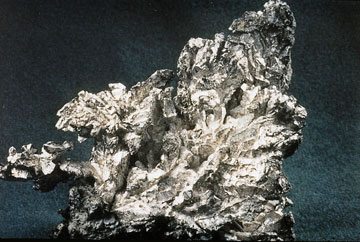What Is Metal?
Chemical element that, in general, (1) is a good conductor of heat and electricity, (2) is opaque but good reflector of light when polished, (3) can be beaten into sheets, (4) can be drawn into wires, (5) produces a sonorous tone when struck. All metals crystallize under suitable conditions and (except cesium, gallium, and mercury) are solid at normal temperature. Chemically, metals tend to form positive ions(are electro positive) and most have strong reactive-affinity with certain non-metallic elements (such as chlorine and sulfur) with which they form salts.
Trace quantities of some metals (such as cobalt, copper,iron, magnesium, potassium, sodium, and zinc) are essential to animal, human, and plant health.
Example of Metals
Iron
Iron is a chemical element with symbol Fe and atomic number 26. It is a metal in the first transition series.It is by mass the most common element on Earth, forming much of Earth's outer and inner core.
Gold
Gold is a chemical element with symbol Au and atomic number 79. In its purest form, it is a bright, slightly reddish yellow, dense, soft, malleable and ductile metal. Chemically, gold is a transition metal and a group 11 element.
Want some?Work harder...
Silver
Silver is the metallic element with the atomic number 47. Its symbol is Ag, from the Latin argentum, from a PIE rootreconstructed as *h₂erǵ-, "grey" or "shining". A soft, white, lustrous transition metal, it possesses the highest electrical conductivity, thermal conductivity, and reflectivity of any metal. The metal occurs naturally in its pure, free form (native silver), as an alloy with gold and other metals, and in minerals such as argentite and chlorargyrite. Most silver is produced as a byproduct of copper, gold, lead, and zinc refining.

Where do metals come from?
Most pure metals, like aluminium, silver and copper, come from the Earth's crust. They are found in ores solid materials called minerals, usually occurring in rock, from which the pure metal has to be extracted. The properties of pure metals can be improved by mixing them with other metals to make alloys.
NON-METAL
Physically, nonmetals tend to be highly volatile (easily vaporised), have low elasticity, and are good insulators of heat and electricity; chemically, they tend to have high ionization energy and electro negativity values, and gain or share electrons when they react with other elements or compounds. Seventeen elements are generally classified as nonmetals; most are gases (hydrogen, helium, nitrogen, oxygen, fluorine, neon, chlorine, argon, krypton, xenon and radon); one is a liquid (bromine), and a few are solids (carbon, phosphorus, sulfur, selenium, and iodine).
FUN FACTS
YAYYYYY
When you inhale helium, you're changing the type of gas molecules in your vocal tract and increasing the speed of the sound of your voice. Some people think that helium changes the pitch of your voice, but the vibration frequency of the vocal cords doesn't change along with the type of gas molecules that surround them.
ANOTHER ONE!!! |
ANOTHER..I MEAN LAST ONE
Nitrogen
Nitrogen is a chemical element with symbol N and atomic number 7. It is the lightest pnictogen and at room temperature, it is a transparent, odorless diatomic gas.
LIST OF METAL AND NON METAL
NON METAL
Group 1: Hydrogen (H)
Group 14: Carbon (C)
Group 15 (the pnictogens): Nitrogen (N), phosphorus (P)
Group 16 (the chalcogens): Oxygen (O), sulfur (S), selenium (Se)
Group 17 (the halogens), all elements: Fluorine (F), chlorine (Cl), bromine (Br), iodine (I), astatine (At)
Group 18 (the noble gases), all elements: Helium (He), neon (Ne), argon (Ar), krypton (Kr), xenon (Xe), radon (Rn)
METAL
LOL it's a lot.But don't worry here is the keyword:
The metals share several common properties, including:
- solid at room temperature (with the exception of mercury)
- usually shiny
- high melting point
- good conductor of heat
- good conductor of electricity
- low ionization energies
- low electronegativities
- malleable – able to be pounded into sheets
- ductile – can be pulled into wire
- high density (exceptions: lithium, potassium and sodium)
- corrodes in air or seawater
- loses electrons in reactions
Mercury is the only metals that is a liquid.
Also there's some metals that you're really need to know;
- Alumunium(Solid)
- Iron(Solid)
- Silver(Solid)
- Copper(Solid)
- Cuprum(Solid)
- Magnesium(Solid)
- Potassium(Solid)
- Tin(Solid)
- Mercury(Liquid)

